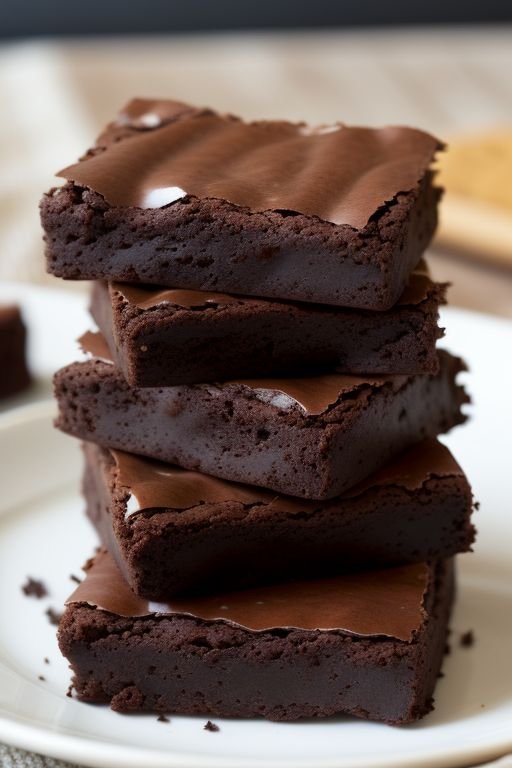Exploring the World of Brownies
What is the brief description of brownies? Brownies, those decadent chocolatey squares, enchant sweet lovers globally. Their rich history might have started as a cake mishap, showing a journey of culinary evolution still ongoing in modern kitchens.
Their origins, debated among American homemakers, have reached global fame in bakeries and homes. Brownies blend simplicity with indulgence perfectly. They are mainly categorized into three types—fudgy, cakey, and blondies. Each type presents a unique texture and flavor, catering to various tastes.
Let’s not just stop at what they are or where they came from. Understanding brownies also involves appreciating their role in various cultural contexts, from casual gatherings to elegant desserts. They’re not just treats; they’re an experience, a slice of joy that can be both nostalgic and excitingly new. So, let’s cut into the history and essence of brownies, exploring what makes them such a beloved dessert around the globe.
Baking Techniques
Mastering the baking techniques for brownies can mean the difference between good and exceptional. Here, we explore crucial steps and tips to help you achieve the perfect batch of brownies, whether you’re aiming for fudgy, cakey, or somewhere in between.
Mixing the Batter
The technique starts with the mixing process. For brownies, the general rule is less is more. Overmixing the batter once the flour is added activates the gluten, leading to a tougher texture. To avoid this, mix just until the dry ingredients are moistened. This will help maintain that sought-after tender crumb.
Baking Temperature and Timing
Temperature is another critical factor. Most brownie recipes call for a moderate oven temperature, typically around 350°F (175°C). This allows the brownies to cook evenly without burning the edges before the middle has set. Preheating the oven is a must to ensure consistent cooking from the moment the pan hits the heat.
Timing is equally important and can vary slightly depending on the oven and the specific recipe. A good rule of thumb for fudgy brownies is to remove them from the oven when a few crumbs stick to a toothpick inserted in the center. This might seem underbaked, but the brownies will continue to set as they cool, resulting in a moist, chewy texture. For cakey brownies, bake until the toothpick comes out mostly clean, which will ensure they are fully cooked through but still soft.
Choosing the Right Pan
Even the pan you choose impacts the outcome. Metal pans are ideal for brownies as they heat up quickly and evenly, preventing the dreaded soggy middle. Glass or ceramic pans can cause the edges to cook faster than the center. If using these types of pans, you might consider lowering the oven temperature by 25°F (about 4°C) and baking for a slightly longer time.
These techniques, when combined with high-quality ingredients and precise measurements, can elevate your brownie baking game. Next, we will look into the nutritional aspects of brownies, providing insights for those interested in healthier or dietary-specific options.
Nutritional Information
What is the brief description of brownies? Understanding the nutritional information of brownies is essential for those who enjoy these treats but are also mindful of their diet. Brownies, by nature, are indulgent, and knowing what goes into them can help you make more informed choices.
Calories and Composition
Typically, a single brownie can contain a significant amount of calories, usually from sugars and fats. The key components such as butter, sugar, chocolate, and eggs contribute not only to the taste and texture but also to the calorie count. For those watching their caloric intake, being aware of the portion size can be crucial.
Healthier Substitutions
For health-conscious bakers, there are several ways to tweak traditional brownie recipes to lower their calorie and fat content. Substituting some of the butter or oil with applesauce or mashed bananas can reduce fat while maintaining moisture. Using a sugar substitute or reducing the amount of sugar can also decrease the overall calorie content without sacrificing sweetness too much.
Dietary Variations
Additionally, for those with dietary restrictions, brownies can be adapted to fit gluten-free and vegan diets. Gluten-free flour blends are readily available and can be used in place of traditional wheat flour. Eggs can be substituted with flaxseed or chia seed mixtures, and dairy-free chocolate and butter alternatives can be used for vegan versions.
Paying attention to these nutritional aspects allows you to enjoy brownies while accommodating your dietary preferences or restrictions. As we move forward, we will delve into the best practices for serving and storing brownies, ensuring you can savor them at their best.
Serving and Storage
Proper serving and storage techniques are key to maximizing the enjoyment and longevity of your brownies. Whether you are presenting them at a party or saving them for later, knowing the best practices can make all the difference.
Serving Brownies
When it comes to serving, presentation can enhance the eating experience. Cutting brownies into neat, uniform squares while they are still slightly warm can help achieve clean edges. Using a sharp knife dipped in hot water and wiped clean between cuts can prevent the brownies from sticking and tearing. Serving them at room temperature usually offers the best flavor and texture, although some prefer the gooey richness of a slightly warmed brownie.
Storing Brownies
Storage is just as crucial as baking. To keep brownies fresh, they should be stored in an airtight container. If left at room temperature, they typically last for several days. For longer storage, you can refrigerate them, which can extend their freshness for up to a week. Ensure they are tightly wrapped or in a sealed container to prevent them from absorbing odors from other foods.
Freezing Brownies
Freezing is another excellent option for extending the life of your brownies. Wrapped individually in plastic wrap and then placed in a zip-lock freezer bag, brownies can be stored in the freezer for up to three months. When ready to eat, simply thaw them at room temperature or give them a quick warm-up in the microwave for a just-baked taste.
These tips ensure that every bite of your brownies is as delicious as the first, whether they are freshly baked or enjoyed over time. Next, we’ll explore popular variations and additions to the classic brownie recipe, adding even more excitement to this beloved treat.



